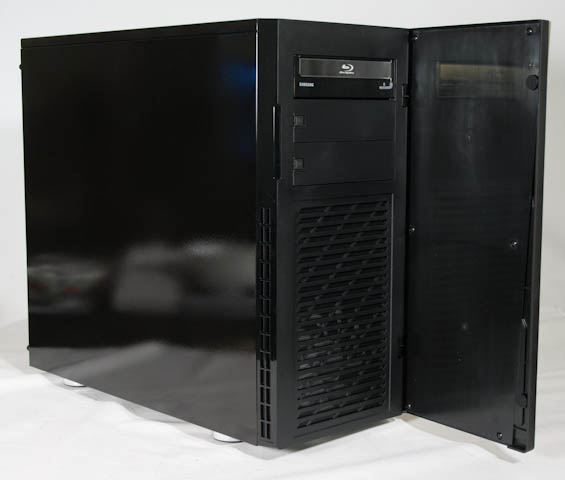NZXT H230 Silent Case Review
by Dustin Sklavos on September 13, 2013 12:00 PM EST- Posted in
- Cases/Cooling/PSUs
- NZXT
- ATX
- Case
The NZXT H230 is a pretty open and shut case, if you'll pardon the utterly freshman grade wordplay. NZXT has a good streak going with the run of Phantoms and their H630, and that streak has essentially come to an end with the H230. NZXT has effectively hit the same wall Corsair tends to: solid hardware from a certain price point up, but having a devil of a time getting the balance right below that point. That's a segment of the market that, ironically, a company like BitFenix will (and does) thrive in.
Build quality of the H230 is for the most part very good, and the aesthetic is pretty simple. Those of you less impressed by the glossy black might be happier with the white version, but overall it at least looks nice enough. The interior has a decent amount of flexibility with the removable drive cage, and the toolless 5.25" drive bay clamps are fantastic, but the drive sleds desperately need to go back to the drawing board.

Unfortunately, once you do get to actually testing the H230, it's pretty much all over. The H230 provides good idle acoustics and that's about it, and unfortunately that's something you can get from other vendors. Load noise is poor with even an arguably modest system configuration, and thermals range from unnervingly hot to downright unacceptable.
I pretty much just plain can't recommend the H230. None of the innovation, creativity, or forward thinking NZXT demonstrated in many of their recent enclosures is evident here; the H230 is instead fairly generic with cripplingly poor performance. Hitting the $69 price point requires a lot of brutal tradeoffs, but I don't feel like NZXT made the right ones. If you're shopping for a silent case at $69, you're better off either tuning an Antec GX700 than going for a case designed specifically for low noise or just trying to expand your budget upward a bit until you hit either the Carbide 330R or a Nanoxia enclosure.










29 Comments
View All Comments
ghitz - Monday, September 16, 2013 - link
Totally agree. 1/3rd of the space of common mITX cases is for the unnecessary large standard ATX PS. We need a new standard.Barbarossa - Sunday, September 15, 2013 - link
You might be right, but standard ATX mid towers and full towers still account for more than 3/4 of all case sales. Mini ITX and Micro ATX are growing, but slowly. It's a bit of chicken and egg scenario, though.Why build Micro ATX system if all the cool cases are ATX or larger? And then once you've already got the case and nothing's wrong with it, when you decide to upgrade, why limit yourself to Micro ATX or smaller?
Don't get me wrong - I think a lot of people are buying smaller PCs, and it's more and more each year, but the vast chunk of the DIY market is still buying standard or full tower cases.
-George @ Corsair
ghitz - Monday, September 16, 2013 - link
Most of them end up being mostly empty.Grok42 - Tuesday, September 17, 2013 - link
I've looked a lot for good stats on that the ATX, mATX and mITX market numbers. Very interesting to know it's still highly skewed toward ATX. I would love to read an article on where the market is and where it appears to be going. I certainly put 100% of the blame for the current emphsis on ATX at the feet of consumers and not companies like Corsair.Dentons - Friday, September 13, 2013 - link
Why not Fractal Design's R4?It's often discounted to the same price as this and was very well reviewed here. It's available from Amazon, Newegg, Microcenter and others. The Nanoxia is very difficult to recommend, not only because of its price, but because it's so hard to find a reseller stocking it.
meacupla - Friday, September 13, 2013 - link
My thoughts exactly.H230 looks exactly like a Define R4, except done worse in every conceivable way...
I would rather pay the extra $10~20 for an R4.
Touche - Saturday, September 14, 2013 - link
You really need to improve your noise floor. There are significant idle noise differences that aren't showing up in your tests.kevith - Saturday, September 14, 2013 - link
For a brief walkthrough and a quick summary, AT´s case reviews are absolutely fine, often with a subtle humor, nice to read.For the in-depth review with an extra emphasis on noise, go to SPCR.
EnzoFX - Saturday, September 14, 2013 - link
This. It's surprising actually since the rest of Anandtech is so thorough. Stark contrast.Barbarossa - Sunday, September 15, 2013 - link
That's easier said than done though. It's not like you can just add some foam to your walls and drop the sound level. Especially if you're reviewing from an apartment or townhouse or something.